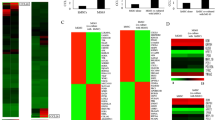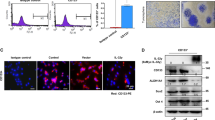Abstract
Nuclear factor-kappa B (NF-κB) has a pivotal role in the progression and distant metastasis of cancers, including malignant bone tumors. To inhibit NF-κB activation, a new molecular therapy using synthetic double-stranded oligodeoxynucleotide (ODN) as a ‘decoy’ cis element against NF-κB has been developed. To determine whether pulmonary metastasis of osteosarcoma is reduced by inhibiting the action of NF-κB, NF-κB decoy ODN was transfected into the nuclei of murine osteosarcoma cells with high pulmonary metastatic potential, the LM8 cell line, using a three-dimensional alginate spheroid culture model. An in vitro study demonstrated the successful transfection of LM8 cells cultured in alginate beads by ‘naked’ NF-κB decoy ODN and that the activation of NF-κB signaling was significantly suppressed. Tumor growth was not affected by transfection of NF-κB decoy ODN, however, the expression of vascular endothelial growth factor (VEGF) and intercellular adhesion molecule 1 (ICAM-1) mRNA was markedly decreased. Furthermore, the transfection of ‘naked’ NF-κB decoy ODN effectively suppressed pulmonary metastasis in an in vivo alginate bead transplantation model. Our results suggest that NF-κB has a central and specific role in the regulation of tumor metastasis and could be a molecular target for development of anti-metastatic treatments for osteosarcoma.
This is a preview of subscription content, access via your institution
Access options
Subscribe to this journal
Receive 12 print issues and online access
$259.00 per year
only $21.58 per issue
Buy this article
- Purchase on Springer Link
- Instant access to full article PDF
Prices may be subject to local taxes which are calculated during checkout








Similar content being viewed by others
References
Uchida A, Myoui A, Araki N, Yoshikawa H, Shinto Y, Ueda T . Neoadjuvant chemotherapy for pediatric osteosarcoma patients. Cancer 1997; 79: 411–415.
Thanos D, Maniatis T . NF-kappa B: a lesson in family values. Cell 1995; 80: 529–532.
Baldwin Jr AS . The NF-kappa B and I kappa B proteins: new discoveries and insights. Annu Rev Immunol 1996; 14: 649–683.
Ravi R, Bedi A . NF-kappaB in cancer—a friend turned foe. Drug Resist Updat 2004; 7: 53–67.
Meyskens Jr FL, Buckmeier JA, McNulty SE, Tohidian NB . Activation of nuclear factor-kappa B in human metastatic melanoma cells and the effect of oxidative stress. Clin Cancer Res 1999; 5: 1197–1202.
Nakshatri H, Bhat-Nakshatri P, Martin DA, Goulet Jr RJ, Sledge Jr GW . Constitutive activation of NF-kappaB during progression of breast cancer to hormone-independent growth. Mol Cell Biol 1997; 17: 3629–3639.
Yokoo T, Kitamura M . Dual regulation of IL-1 beta-mediated matrix metalloproteinase-9 expression in mesangial cells by NF-kappa B and AP-1. Am J Physiol 1996; 270: F123–F130.
Yoshida S, Ono M, Shono T, Izumi H, Ishibashi T, Suzuki H et al. Involvement of interleukin-8, vascular endothelial growth factor, and basic fibroblast growth factor in tumor necrosis factor alpha-dependent angiogenesis. Mol Cell Biol 1997; 17: 4015–4023.
Park BK, Zhang H, Zeng Q, Dai J, Keller ET, Giordano T et al. NF-kappaB in breast cancer cells promotes osteolytic bone metastasis by inducing osteoclastogenesis via GM-CSF. Nat Med 2007; 13: 62–69.
Huang S, Pettaway CA, Uehara H, Bucana CD, Fidler IJ . Blockade of NF-kappaB activity in human prostate cancer cells is associated with suppression of angiogenesis, invasion, and metastasis. Oncogene 2001; 20: 4188–4197.
Huang S, DeGuzman A, Bucana CD, Fidler IJ . Nuclear factor-kappaB activity correlates with growth, angiogenesis, and metastasis of human melanoma cells in nude mice. Clin Cancer Res 2000; 6: 2573–2581.
Andela VB, Sheu TJ, Puzas EJ, Schwarz EM, O’Keefe RJ, Rosier RN . Malignant reversion of a human osteosarcoma cell line, Saos-2, by inhibition of NFkappaB. Biochem Biophys Res Commun 2002; 297: 237–241.
Andela VB, Siddiqui F, Groman A, Rosier RN . An immunohistochemical analysis to evaluate an inverse correlation between Runx2/Cbfa1 and NF kappa B in human osteosarcoma. J Clin Pathol 2005; 58: 328–330.
Asai T, Tomita Y, Nakatsuka S, Hoshida Y, Myoui A, Yoshikawa H et al. VCP (p97) regulates NFkappaB signaling pathway, which is important for metastasis of osteosarcoma cell line. Jpn J Cancer Res 2002; 93: 296–304.
Harimaya K, Tanaka K, Matsumoto Y, Sato H, Matsuda S, Iwamoto Y . Antioxidants inhibit TNFalpha-induced motility and invasion of human osteosarcoma cells: possible involvement of NFkappaB activation. Clin Exp Metastasis 2000; 18: 121–129.
Kishida Y, Yoshikawa H, Myoui A . Parthenolide, a natural inhibitor of Nuclear Factor-kappaB, inhibits lung colonization of murine osteosarcoma cells. Clin Cancer Res 2007; 13: 59–67.
Mori K, Le Goff B, Berreur M, Riet A, Moreau A, Blanchard F et al. Human osteosarcoma cells express functional receptor activator of nuclear factor-kappa B. J Pathol 2007; 211: 555–562.
Morishita R, Sugimoto T, Aoki M, Kida I, Tomita N, Moriguchi A et al. In vivo transfection of cis element ‘decoy’ against nuclear factor-kappaB binding site prevents myocardial infarction. Nat Med 1997; 3: 894–899.
Morishita R, Tomita N, Kaneda Y, Ogihara T . Molecular therapy to inhibit NFkappaB activation by transcription factor decoy oligonucleotides. Curr Opin Pharmacol 2004; 4: 139–146.
Kawamura I, Morishita R, Tomita N, Lacey E, Aketa M, Tsujimoto S et al. Intratumoral injection of oligonucleotides to the NF kappa B binding site inhibits cachexia in a mouse tumor model. Gene Ther 1999; 6: 91–97.
Kawamura I, Morishita R, Tsujimoto S, Manda T, Tomoi M, Tomita N et al. Intravenous injection of oligodeoxynucleotides to the NF-kappaB binding site inhibits hepatic metastasis of M5076 reticulosarcoma in mice. Gene Ther 2001; 8: 905–912.
Asai T, Ueda T, Itoh K, Yoshioka K, Aoki Y, Mori S et al. Establishment and characterization of a murine osteosarcoma cell line (LM8) with high metastatic potential to the lung. Int J Cancer 1998; 76: 418–422.
Akeda K, Nishimura A, Satonaka H, Shintani K, Kusuzaki K, Matsumine A et al. Three-dimensional alginate spheroid culture system of murine osteosarcoma. Oncol Rep 2009; 22: 997–1003.
Dunn TB, Andervont HB . Histology of some neoplasms and non-neoplastic lesions found in wild mice maintained under laboratory conditions. J Natl Cancer Inst 1963; 31: 873–901.
Masuda K, Takegami K, An H, Kumano F, Chiba K, Andersson GB et al. Recombinant osteogenic protein-1 upregulates extracellular matrix metabolism by rabbit annulus fibrosus and nucleus pulposus cells cultured in alginate beads. J Orthop Res 2003; 21: 922–930.
Renard P, Ernest I, Houbion A, Art M, Le Calvez H, Raes M et al. Development of a sensitive multi-well colorimetric assay for active NFkappaB. Nucleic Acids Res 2001; 29: E21.
Imai Y, Miyamoto K, An HS, Thonar EJ, Andersson GB, Masuda K . Recombinant human osteogenic protein-1 upregulates proteoglycan metabolism of human anulus fibrosus and nucleus pulposus cells. Spine 2007; 32: 1303–1309;discussion 1310.
Matsumine A, Shintani K, Kusuzaki K, Matsubara T, Satonaka H, Wakabayashi T et al. Expression of decorin, a small leucine-rich proteoglycan, as a prognostic factor in soft tissue tumors. J Surg Oncol 2007; 96: 411–418.
Horiuchi K, Morioka H, Nishimoto K, Suzuki Y, Susa M, Nakayama R et al. Growth suppression and apoptosis induction in synovial sarcoma cell lines by a novel NF-kappaB inhibitor, dehydroxymethylepoxyquinomicin (DHMEQ). Cancer Lett 2008; 272: 336–344.
Wu JM, Sheng H, Saxena R, Skill NJ, Bhat-Nakshatri P, Yu M et al. NF-kappaB inhibition in human hepatocellular carcinoma and its potential as adjunct to sorafenib based therapy. Cancer Lett 2009; 278: 145–155.
Nishimura D, Ishikawa H, Matsumoto K, Shibata H, Motoyoshi Y, Fukuta M et al. DHMEQ, a novel NF-kappaB inhibitor, induces apoptosis and cell-cycle arrest in human hepatoma cells. Int J Oncol 2006; 29: 713–719.
Horiguchi Y, Kuroda K, Nakashima J, Murai M, Umezawa K . Antitumor effect of a novel nuclear factor-kappa B activation inhibitor in bladder cancer cells. Expert Rev Anticancer Ther 2003; 3: 793–798.
Zucchini C, Rocchi A, Manara MC, De Sanctis P, Capanni C, Bianchini M et al. Apoptotic genes as potential markers of metastatic phenotype in human osteosarcoma cell lines. Int J Oncol 2008; 32: 17–31.
Um JH, Kwon JK, Kang CD, Kim MJ, Ju DS, Bae JH et al. Relationship between antiapoptotic molecules and metastatic potency and the involvement of DNA-dependent protein kinase in the chemosensitization of metastatic human cancer cells by epidermal growth factor receptor blockade. J Pharmacol Exp Ther 2004; 311: 1062–1070.
Folkman J . The role of angiogenesis in tumor growth. Semin Cancer Biol 1992; 3: 65–71.
Huang WC, Chan ST, Yang TL, Tzeng CC, Chen CC . Inhibition of ICAM-1 gene expression, monocyte adhesion and cancer cell invasion by targeting IKK complex: molecular and functional study of novel alpha-methylene-gamma-butyrolactone derivatives. Carcinogenesis 2004; 25: 1925–1934.
Lee YH, Tokunaga T, Oshika Y, Suto R, Yanagisawa K, Tomisawa M et al. Cell-retained isoforms of vascular endothelial growth factor (VEGF) are correlated with poor prognosis in osteosarcoma. Eur J Cancer 1999; 35: 1089–1093.
Lin YC, Shun CT, Wu MS, Chen CC . A novel anticancer effect of thalidomide: inhibition of intercellular adhesion molecule-1-mediated cell invasion and metastasis through suppression of nuclear factor-kappaB. Clin Cancer Res 2006; 12: 7165–7173.
Tannock IF, Hill RP, Bristow RG, Harrington L . Tumor Progressin and Metastasis: Cellular, Molecular, and Microenvironment Factors. In: Khokha R, Voura E, Hill RP (eds). The Basic Science of Oncology, Fourth edn The McGraw-Hill Companies, Inc.: New York, 2004, pp 205–230.
Roque F, Mon G, Belardi J, Rodriguez A, Grinfeld L, Long R et al. Safety of intracoronary administration of c-myc antisense oligomers after percutaneous transluminal coronary angioplasty (PTCA). Antisense Nucleic Acid Drug Dev 2001; 11: 99–106.
Miyao T, Takakura Y, Akiyama T, Yoneda F, Sezaki H, Hashida M . Stability and pharmacokinetic characteristics of oligonucleotides modified at terminal linkages in mice. Antisense Res Dev 1995; 5: 115–121.
Higuchi Y, Kawakami S, Oka M, Yabe Y, Yamashita F, Hashida M . Intravenous administration of mannosylated cationic liposome/NFkappaB decoy complexes effectively prevent LPS-induced cytokine production in a murine liver failure model. FEBS Lett 2006; 580: 3706–3714.
De Vry CG, Prasad S, Komuves L, Lorenzana C, Parham C, Le T et al. Non-viral delivery of nuclear factor-kappaB decoy ameliorates murine inflammatory bowel disease and restores tissue homeostasis. Gut 2007; 56: 524–533.
Desmet C, Gosset P, Pajak B, Cataldo D, Bentires-Alj M, Lekeux P et al. Selective blockade of NF-kappa B activity in airway immune cells inhibits the effector phase of experimental asthma. J Immunol 2004; 173: 5766–5775.
Inagaki H, Suzuki J, Ogawa M, Taniyama Y, Morishita R, Isobe M . Ultrasound-microbubble-mediated NF-kappaB decoy transfection attenuates neointimal formation after arterial injury in mice. J Vasc Res 2006; 43: 12–18.
Azuma H, Tomita N, Sakamoto T, Kiyama S, Inamoto T, Takahara K et al. Marked regression of liver metastasis by combined therapy of ultrasound-mediated NF kappaB-decoy transfer and transportal injection of paclitaxel, in mouse. Int J Cancer 2008; 122: 1645–1656.
Matsubara T, Akeda K, Nishimura A, Kusuzaki K, Matsumine A, Shintani K et al. Injection of naked decoy oligodeoxynucleotide against nuclear factor-kappa B into a murine osteosarcoma in a spontaneous pulmonary metastasis model. Trans Orthop Res Soc 2008; 33: 1196.
Acknowledgements
We thank Takahiro Iino and Kei Chiba for their technical assistance. This study was sponsored by grants from the Uehara Memorial Life Science Foundation and from the Ministry of Education, Culture, Sports, Science and Technology (Japan).
Author information
Authors and Affiliations
Corresponding author
Ethics declarations
Competing interests
The authors declare no conflict of interest.
Rights and permissions
About this article
Cite this article
Nishimura, A., Akeda, K., Matsubara, T. et al. Transfection of NF-κB decoy oligodeoxynucleotide suppresses pulmonary metastasis by murine osteosarcoma. Cancer Gene Ther 18, 250–259 (2011). https://doi.org/10.1038/cgt.2010.75
Received:
Revised:
Accepted:
Published:
Issue Date:
DOI: https://doi.org/10.1038/cgt.2010.75
Keywords
This article is cited by
-
Applications and advancements of nanoparticle-based drug delivery in alleviating lung cancer and chronic obstructive pulmonary disease
Naunyn-Schmiedeberg's Archives of Pharmacology (2023)
-
Osteosarcoma tumor microenvironment: the key for the successful development of biologically relevant 3D in vitro models
In vitro models (2022)
-
Modeling the therapeutic efficacy of NFκB synthetic decoy oligodeoxynucleotides (ODNs)
BMC Systems Biology (2018)
-
Relevance of 3d culture systems to study osteosarcoma environment
Journal of Experimental & Clinical Cancer Research (2018)
-
Protein phosphatase 2A Cα regulates proliferation, migration, and metastasis of osteosarcoma cells
Laboratory Investigation (2016)



